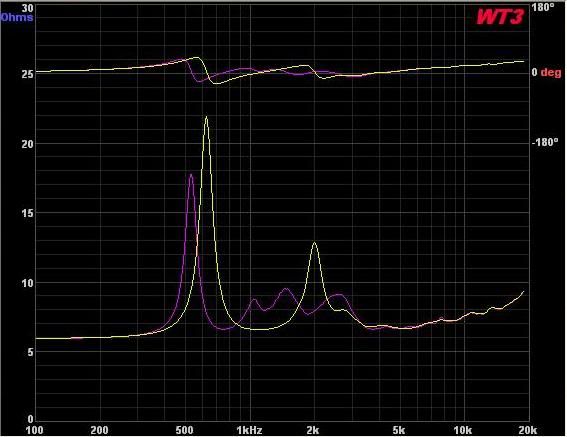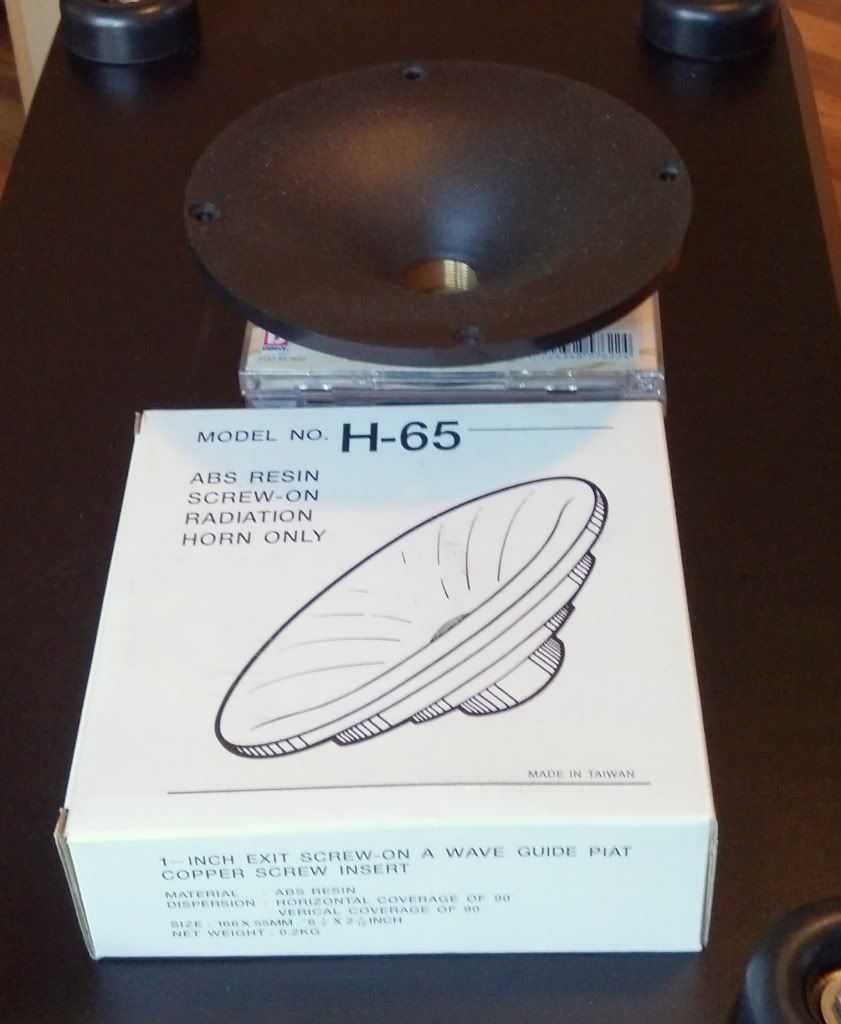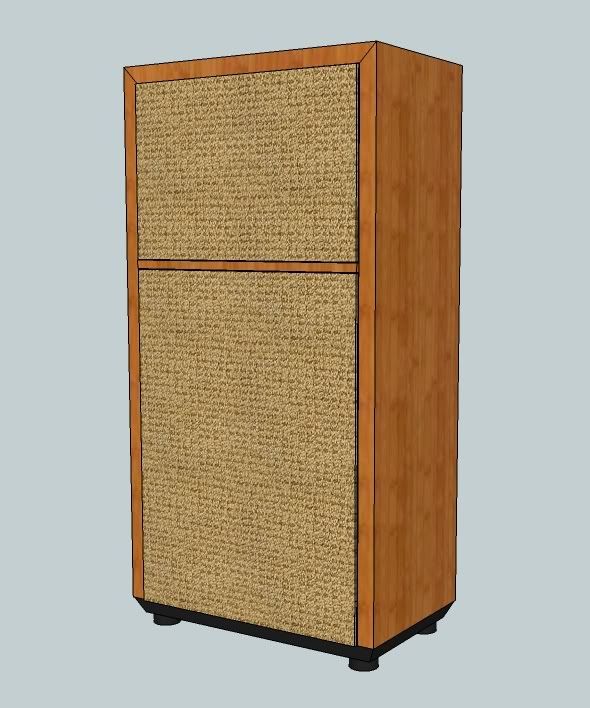I am building a set of speakers with a horn tweeter and have come down to a couple of choices for the horn.

The driver is Selenium D220Ti. The purple line is with the Selenium HC23-25 horn:
Selenium HC23-25 1" Exponential Horn 100x40 1-3/8"-18 TPI 264-318
The yellow line is a Taiwanese 6 1/2" 'waveguide' horn:

MCM sold them a few years ago, but don't seem to any more. The box states a 90 degree dispersion.
My project is a passive 3-way, crossed to the tweeter at about 2 Khz. My question is if anyone can explain to me the differences in the impedance curves and how each might affect the sound. Also, what might the best way to compensate for the impedance variation of each in the crossover be?
Thanks!

The driver is Selenium D220Ti. The purple line is with the Selenium HC23-25 horn:
Selenium HC23-25 1" Exponential Horn 100x40 1-3/8"-18 TPI 264-318
The yellow line is a Taiwanese 6 1/2" 'waveguide' horn:

MCM sold them a few years ago, but don't seem to any more. The box states a 90 degree dispersion.
My project is a passive 3-way, crossed to the tweeter at about 2 Khz. My question is if anyone can explain to me the differences in the impedance curves and how each might affect the sound. Also, what might the best way to compensate for the impedance variation of each in the crossover be?
Thanks!
That peak @ 2kHz must also show up on the response curve. I wonder what is looks like?
If there is a way to remove that peak then the Chinese version has a much smoother impedance curve.
If there is a way to remove that peak then the Chinese version has a much smoother impedance curve.
It does look smoother, but I am wondering if it is just 'bunched'...?That peak @ 2kHz must also show up on the response curve. I wonder what is looks like?
If there is a way to remove that peak then the Chinese version has a much smoother impedance curve.
I am thinking maybe a low Q notch zobel will help the secondary ripple on the Selenium horn, but I thought I would let some of the horn experts here have a look at it.
I had heard it was a bad idea to run a driver without a horn attached...?Have you impedance graph without horn?..
I think the WT3 docs say the signal is about 1.4 volts - any risk??
If you are using second order crossovers you can cross this driver at 3 kHz. The impedance peak at 2 kHz will make the driver sound there and cover for the loss of sound from the woofer at 2 kHz when it too is crossed over at 3 kHz.
Hi
Your purple impedance curve shows a horn which is loading the driver more (more efficient, likely more sensitive) than the other.
Normally this would show up in the response curve also with the most (greater than the yellow) efficient range for the purple case being in the 1 to 3Khz range.
As to where to crossover, let the raw response curve be a strong guide to that, that is where the horn / driver system is all by itself.
It is that magnitude and phase that combines with the range below or above, that raw response you need to make “flat and happy” to paraphrase my aunt..
In order to make the horn have “flat” response, the crossover should also accommodate the attenuation needed below 15-20Khz to get the desired response.
Generally, the more you have to attenuate below that, the less important the impedance curve becomes to the eq part of the circuitry but the main peak (lower) is often part of horn gak interacting with the high pass filter if not dealt with..
That attenuation ideally compliments the drivers magnitude and phase so the result is a correct driver and to the degree you have say attenuated 12 dB of level midband, you have lowered the driver power by 16 to 1 and this reduces nearly all bad stuff drivers do.
Best,
Tom
Your purple impedance curve shows a horn which is loading the driver more (more efficient, likely more sensitive) than the other.
Normally this would show up in the response curve also with the most (greater than the yellow) efficient range for the purple case being in the 1 to 3Khz range.
As to where to crossover, let the raw response curve be a strong guide to that, that is where the horn / driver system is all by itself.
It is that magnitude and phase that combines with the range below or above, that raw response you need to make “flat and happy” to paraphrase my aunt..
In order to make the horn have “flat” response, the crossover should also accommodate the attenuation needed below 15-20Khz to get the desired response.
Generally, the more you have to attenuate below that, the less important the impedance curve becomes to the eq part of the circuitry but the main peak (lower) is often part of horn gak interacting with the high pass filter if not dealt with..
That attenuation ideally compliments the drivers magnitude and phase so the result is a correct driver and to the degree you have say attenuated 12 dB of level midband, you have lowered the driver power by 16 to 1 and this reduces nearly all bad stuff drivers do.
Best,
Tom
see item #10 in http://www.eighteensound.com/staticContent/download/pdf/18Sound_diaphragm_procedure.pdf for example.I had heard it was a bad idea to run a driver without a horn attached...?
xxx mV above xxx Hz are definitely safe for driver.
second purple peak looks as driver throat resonance.
Thanks everyone for your responses.
I fired up the Omni-mic and have made some response comparisons. Distance was about six inches, centered, with a set level.

This is with no horn.

This is with the little Chinese horn.

This is with the Selenium horn.
The response on the little horn surprised me. It seems to hold bandwidth pretty well off axis as well. The Selenium horn looks much flatter at about plus and minus 20 degrees horizontal, response falls off rapidly vertically, but that's okay as the speaker has the horn at ear height anyway. The response above 15Khz never does do as well as the little horn.
BTW here is a sketchup rendition of the envisioned speaker:

It is 25.5 inches wide, 15 inches deep, and 50 inches tall. Wood is teak.
Comments?
I fired up the Omni-mic and have made some response comparisons. Distance was about six inches, centered, with a set level.

This is with no horn.

This is with the little Chinese horn.

This is with the Selenium horn.
The response on the little horn surprised me. It seems to hold bandwidth pretty well off axis as well. The Selenium horn looks much flatter at about plus and minus 20 degrees horizontal, response falls off rapidly vertically, but that's okay as the speaker has the horn at ear height anyway. The response above 15Khz never does do as well as the little horn.
BTW here is a sketchup rendition of the envisioned speaker:

It is 25.5 inches wide, 15 inches deep, and 50 inches tall. Wood is teak.
Comments?
Last edited:
This is the project thread, just FYI....
http://www.diyaudio.com/forums/multi-way/190036-classic-3-way-hi-fi-speakers.html
http://www.diyaudio.com/forums/multi-way/190036-classic-3-way-hi-fi-speakers.html
- Status
- Not open for further replies.
- Home
- Loudspeakers
- Multi-Way
- Horn Impedance